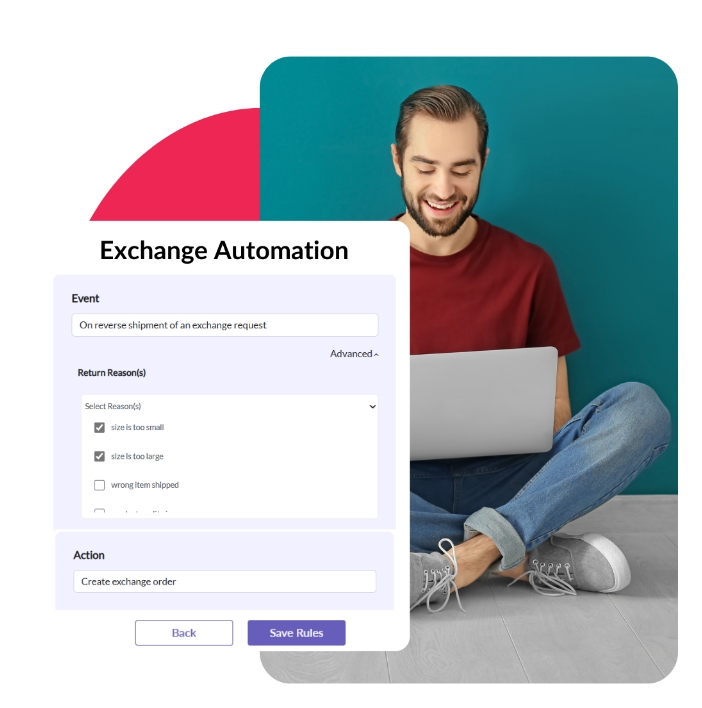In the ever-evolving world of e-commerce, customer satisfaction reigns supreme. A report by NICE reveals that 95% of consumers say value easy access, self-service, and interaction is crucial for brand loyalty.
This underscores the critical importance of an efficient and customer-centric return process in driving repeat business and fostering brand loyalty. In this digital age, where convenience and transparency are paramount, Shopify self-service returns emerge as a game-changer, revolutionizing the way businesses manage return requests and elevate the customer experience.
Shopify, a leading e-commerce platform empowering over 1.7 million businesses worldwide, recognizes the significance of self-service returns in today’s competitive landscape. With the rise of online shopping, the demand for seamless return experiences has never been higher. According to Statista, global retail e-commerce sales hit approximately 5.8 trillion U.S. dollars in 2023. Projections suggest a 39% growth, reaching over eight trillion dollars by 2027. This highlights the immense opportunity for businesses to capitalize on this growing market.


Shopify self-service returns empower customers to take control of their return journey directly through their Shopify accounts. This functionality streamlines the return process by automating tasks such as generating return labels, processing refunds, and updating inventory. With the returns portal serving as the central hub for customers to access self-service returns functionality, businesses can provide a seamless and intuitive return experience that enhances satisfaction and fosters long-term loyalty.
In this blog, we’ll explore the essential role of self-service returns in modern e-commerce on Shopify. From understanding the benefits of self-service returns to navigating common challenges and implementing best practices, we’ll delve into how businesses can leverage this feature to drive success in the digital age.
Understanding Shopify Self-Service Returns:
Shopify self-service returns represent a customer-centric solution that transforms the way return requests are managed in ecommerce. This feature empowers customers to independently initiate and oversee return processes directly through their Shopify accounts. Alongside this, the returns portal serves as the central platform where customers access self-service returns functionality.
Customers may easily handle the return procedure by using the return portal. Customers can use their Shopify dashboard to pick items for return, specify why they are returning them, and select their preferred resolutions. Through the reduction of hassle and improvement of user experience, this integration speeds up the return journey.
Moreover, the returns portal fosters transparency and communication throughout the return process. Customers receive real-time updates on the status of their return requests, including notifications for label generation, refund processing, and item reception by the merchant. This transparency builds trust and reinforces positive customer interactions.
All things considered, Shopify self-service returns, made possible via the returns portal, give consumers command over their return experience while simplifying business processes for sellers. This customer-focused strategy boosts contentment, encourages steadfastness, and drives achievement in the competitive world of online retail.


Why Shopify Self-Service Returns is Important?
Customer Empowerment:
Perhaps the most significant aspect of Shopify self-service returns is the empowerment it provides to customers. By giving customers control over their return experience, Shopify fosters a sense of autonomy and agency. Customers can initiate return requests, select preferred resolutions (such as refunds or exchanges), and track the status of their returns—all without the need for manual intervention from the merchant’s end.
This empowerment not only enhances the customer experience but also builds trust and loyalty. Customers appreciate the convenience and transparency of self-service returns, leading to higher levels of satisfaction and repeat business.
Reducing Manual Intervention through Automation:
For merchants, Shopify’s self-service returns feature represents a shift towards a more hands-off approach to returns management. Customers can initiate return requests directly through their Shopify accounts, sparing merchants from having to field return inquiries via email or phone. This reduction in manual intervention not only frees up valuable time for merchants but also minimizes the risk of errors or delays in processing returns.
Additionally, Shopify’s self-service returns feature automates the processing of refunds, ensuring prompt and hassle-free reimbursement for customers. With just a few clicks, customers can initiate a refund request, and Shopify takes care of the rest, seamlessly processing the refund and updating the customer’s account balance accordingly.
Furthermore, self-service returns on Shopify facilitate real-time inventory updates, ensuring merchants have accurate visibility into their stock levels. When a return is initiated, Shopify automatically adjusts inventory counts, allowing merchants to manage their inventory more effectively and avoid overselling or stockouts.


Operational Efficiency:
By automating various aspects of the return process, such as label generation and refund processing, Shopify reduces the manual workload on businesses, freeing up valuable time and resources. This efficiency allows merchants to focus on core business activities, such as product development and marketing, driving growth and profitability.
Moreover, operational efficiency extends beyond mere time and resource savings; it encompasses delivering an exceptional customer experience. With Shopify self-service returns, businesses gain access to real-time insights into return trends and customer behavior.
By analyzing data on return reasons, patterns, and resolutions, merchants can pinpoint areas for enhancement and refine their operations. This data-driven approach empowers businesses to make informed decisions that not only improve efficiency but also enhance overall performance.
Navigating Common Challenges:
Personalized Assistance vs. Automation:
One of the key challenges in implementing Shopify self-service returns is balancing the benefits of automation with the need for personalized customer assistance. While self-service returns offer efficiency and convenience, certain product categories or customer segments may require human intervention for complex issues or personalized support. Businesses must find the right balance between automation and personalized assistance to meet diverse customer needs effectively.
Complexity Management:
Shopify self-service returns may encounter challenges in addressing the complexity of product returns, particularly for items that require specialized handling or troubleshooting. Products such as electronics or customized items may present unique return scenarios that cannot be fully addressed through automated processes alone. Businesses must develop strategies to manage these complexities and ensure a seamless return experience for customers.
Upholding Brand Trust:
While self-service returns offer efficiency and convenience, they also risk diluting direct interactions and personalized experiences, which are crucial for building and maintaining brand trust. Businesses must tread carefully to ensure that self-service returns align with their brand values and uphold the integrity of the customer experience. Clear communication, transparency, and responsiveness are essential in maintaining trust and loyalty.
Strategies for Maximizing Shopify Self-Service Returns:
Customization and Flexibility: To maximize the benefits of Shopify self-service returns, businesses can customize and tailor the return process to accommodate the unique needs of their customers. Offering flexible return options, clear communication channels, and personalized support can enhance the customer experience and drive satisfaction.
Data-Driven Insights: Leveraging data analytics is crucial for optimizing Shopify self-service returns. By analyzing return trends, customer feedback, and product performance metrics, businesses can gain valuable insights into customer behavior and preferences. These insights can inform decision-making, improve inventory management, and identify opportunities for process optimization.
Integration Capabilities: Shopify’s ecosystem offers integration capabilities that enable businesses to seamlessly connect self-service returns with other platform features and third-party apps. By integrating return management with order fulfillment, inventory tracking, and customer support, businesses can create a cohesive e-commerce experience that enhances efficiency and customer satisfaction.
The Future of Shopify Self-Service Returns:
Continuous Innovation: Shopify remains committed to innovation and continuous improvement, with ongoing updates and enhancements to the self-service returns feature based on user feedback and market trends. As e-commerce evolves, Shopify will continue to innovate and adapt to meet the changing needs and expectations of merchants and customers.
Adaptation and Evolution: As consumer preferences and industry trends evolve, Shopify self-service returns will continue to adapt and evolve to remain relevant and effective. Businesses must stay agile and proactive in embracing change, leveraging emerging technologies, and implementing best practices to optimize the self-service returns process and drive success in the dynamic e-commerce landscape.
In conclusion, Shopify’s self-service returns are an excellent instance of technological advancement in the constantly evolving e-commerce industry. The standards of the return procedure is closely tied to customer satisfaction and goodwill. Shopify’s dedication to delivering a smooth and customer-focused return experience is indicative of the platform’s grasp of the demands and expectations faced by modern consumers.
Shopify gives customers the ability to take charge of their return process through the return site, promoting transparency, confidence, and customer happiness. Beyond just being convenient, this empowerment fosters enduring loyalty and propels company growth in the cutthroat world of online retail.
As we look towards the future, the role of self-service returns in e-commerce will only continue to grow in significance!



